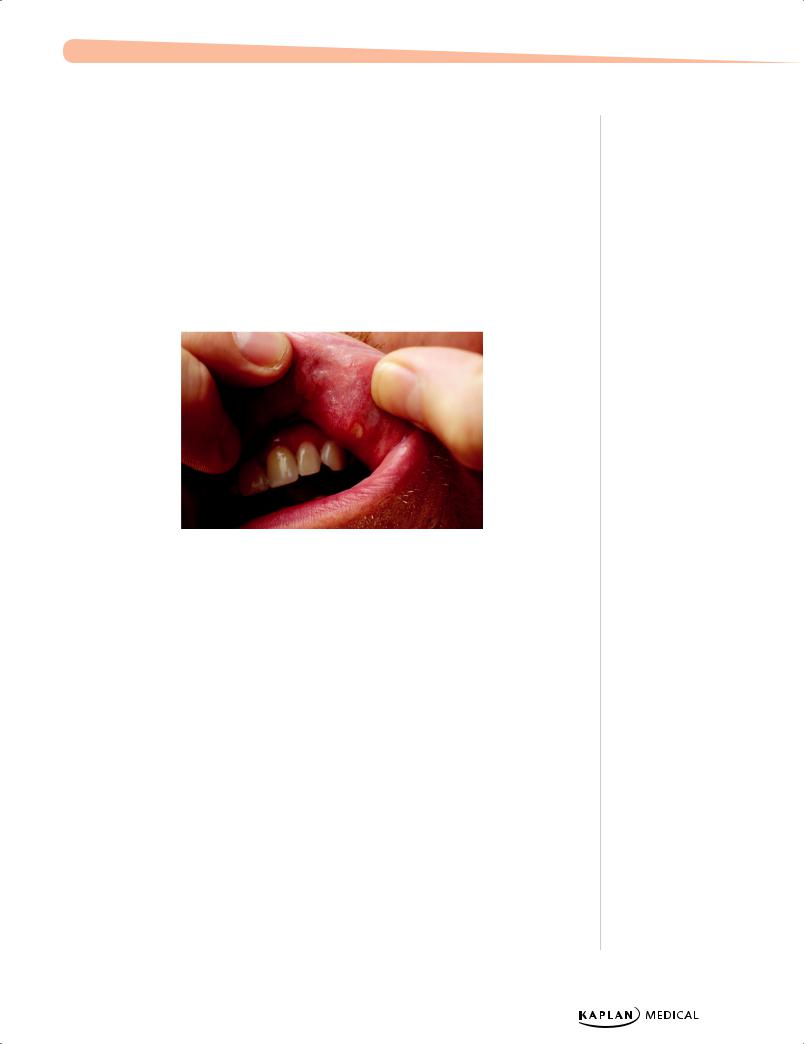USMLE Step 2 CK λ Pediatrics
−Interstitial pneumonia
−Myocarditis
•Prognosis
−Most cases resolve in 2–4 weeks; some disability that comes and goes for a few months is common; and there may be fatigue for a few years
−There is no evidence of second attacks from EBV and no evidence that EBV is related to chronic fatigue syndrome
Influenza Viruses
A 14-year-old girl is brought to the physician’s office by her mother. She has a 2-day history of fever of 39.7 C (103.5 F), headache, sore throat, refusal to eat, myalgia, chills and non-productive cough. Her current temperature in the clinic is 39.3 C (102.7 F).
•Etiology/Risk Factors
–Three types—A, B, and C, with A and B being the primary pathogens of epidemic disease; now, also since 2009, H1N1
–Migratory avian hosts may be responsible for spread.
–Annual spread between Northern and Southern hemispheres; origin of new strains often traced to Asia
–One or 2 predominant strains spread annually
–Attack rate highest in the young; colder months in temperate climates
–Transmission by small particle aerosol
•Clinical presentation
− Predominantly respiratory illness
− Abrupt onset with coryza, conjunctivitis, pharyngitis, and dry cough
− Prominent systemic signs: fever (2–4 days), myalgia, malaise, headache
•Diagnosis
− Virus can be isolated from nasopharynx early in course. − Rapid diagnostic test: ELISA
− Can be confirmed serologically with acute and convalescent titers or PCR
•Treatment
− Rest and adequate fluid intake − Control of fever
− Antiviral drugs: decrease severity and duration if administered within first 48 hours of symptoms
•Complications—otitis media, pneumonia; secondary bacterial infection, myocarditis
254
Chapter 22 λ Infectious Disease
Coxsackievirus
A 2-year-old infant is brought to the clinic with a vesicular rash in his mouth and on his palms and soles. Examination reveals a rash on his buttocks.
•Etiology/Risk Factors—due to infection with coxsackievirus A16
•Clinical diagnosis: Characteristic lesions—seen anywhere but especially on the oral mucosa, hands and feet; hand-foot-mouth disease. Rash on the buttocks is common.
•Coxsackievirus B also responsible for viral myocarditis
•Treatment is supportive care
Copyright 2007 - Custom Medical Stock Photo.
Figure 22-4. Oral Ulcers of Hand-Foot-and-Mouth Disease
Adenovirus
A 12-year-old patient presents with fever, sore throat, and follicular conjunctivitis.
•Etiology/Risk Factors—DNA virus responsible for URIs in infants and children
•Clinical Presentation—Fever, pharyngitis, conjunctivitis, and diarrhea are common.
–Less common features include pharyngoconjunctival fever, myocarditis, and intussusception.
•Diagnosis—serology, viral culture, or PCR, but not usually necessary
•Treatment—supportive
Poliovirus
•Etiology/Risk Factors—lives in gastrointestinal track
•Clinical Presentation—can cause URI symptoms − Paralytic polio
º Asymmetric flaccid paralysis
•Prevent with vaccination
Published by dr-notes.com |
255 |
|
|
|
USMLE Step 2 CK λ Pediatrics
Acquired Immunodeficiency Syndrome (AIDS)
An 18-month-old has failure to thrive and developmental delay. The patient also has a history of recurrent ear infections, oral thrush, and chronic diarrhea. The patient on physical examination today is noted to have lymphadenopathy.
•Etiology/Risk Factors
–Most are children born in developing countries; acquired at birth from an HIVpositive mother
–Breastfeeding in developing countries is an important route of transmission.
–Pregnant females in United States and other developed countries are routinely screened for HIV infection in prenatal labs, unless the patient refuses.
ºEarly treatment and prevention of neonatal infection through anti-retroviral therapy and preventive measures during delivery/postpartum period
•Clinical presentation
–HIV-infected newborns: rapid onset of symptoms and AIDS in first few months of life
−Initial symptoms may include
ºLymphadenopathy
ºHepatosplenomegaly
ºFailure to thrive
ºChronic diarrhea
ºInterstitial pneumonia
ºOral thrush
−Children > adults: recurrent bacterial infections, chronic parotid swelling, lymphocytic interstitial pneumonitis, early progressive neurological deterioration
•Infections
−Recurrent bacterial infections with encapsulated organisms and other grampositive and gram-negative organisms
−Opportunistic infections; most common is PCP (onset of fever, tachypnea, dyspnea, and marked hypoxemia)
−Mycobacterium avian-intracellulare complex: disseminated disease in severely compromised
−Oral candidiasis and other invasive fungal infections
−Viral infections, especially herpes group
•Other problems
−CNS disease
−Cardiomyopathy
−Enteropathy
−Wasting syndrome, nephropathy
−Many cutaneous manifestations
−All hematologic manifestations, malignancies
256
Chapter 22 λ Infectious Disease
•Diagnosis
− HIV-DNA by PCR
– Maternal HIV IgG antibodies cross the placenta
ºScreen will be positive in all newborns up to age 18 months so need 2 of 3PCR for HIV in first month of life.
−In any child >18 months of age: test for infection through IgG Ab by ELISA and then confirm with Western blot to establish the diagnosis.
•Treatment—infants born to HIV-infected mothers
– Mother should be on perinatal triple anti-retroviral therapy and then IV ZDV at start of labor until cord is clamped
– Infant should be started on ZDV (birth) until neonatal disease is excluded
ºAlso start PCP prophylaxis (TMP-SMZ) at 1 month until disease excluded
ºFollow CBC, platelets, CD4 and CD8 counts
ºWith symptoms or evidence of immune dysfunction, should be treated with antiretroviral therapy, regardless of age or viral load
•Prognosis
−Best single prognostic indicator is the plasma viral load.
−Mortality higher with CD4 count <15%
−Poor prognosis with persistent fever and/or thrush, serious bacterial infection (meningitis), hepatitis, persistent anemia, and/or thrombocytopenia (30% die by age 3)
−Children with opportunistic infection, encephalopathy, or wasting syndrome have the worst prognosis (75% die by age <3)
Clinical Recall
Which of the following best supports a diagnosis of coxsackie virus A?
A.New rash after treatment with amoxicillin
B.Diffuse rash with ulcerative lesions in the mouth
C.Myalgias, fever, and dry cough of abrupt onset
D.Chest pain and myocardial infection
E.Diarrhea and pharyngitis
Answer: B
Published by dr-notes.com |
257 |
|
|
|
USMLE Step 2 CK λ Pediatrics
Note
Loeffler syndrome = pulmonary ascariasis plus hemoptysis
Note
Most parasites, ova, and cysts can be identified on fecal smear.
258
HELMINTHIC DISEASES
Ascariasis
A child is brought to the physician’s office because his mother found a “worm” while changing his diaper. He also has a chronic cough with pinkish sputum.
•Etiology/Pathogenesis—Ascaris lumbricoides; nematode (roundworm) − Most prevalent human helminth in the world
–High prevalence in poor socioeconomic status countries, with use of human waste as fertilizer, and with geophagia (highest in preschool age)
–Travels to the small intestines → releases larvae → migrates through venous circulation to lungs and causes pulmonary ascariasis (Loeffler syndrome) → through alveoli and bronchi to trachea and are swallowed mature in intestine to adult worms
•Clinical Presentation—most asymptomatic or mild
–Most common symptom is pulmonary disease—cough and blood-stained sputum
–Followed by obstructive intestinal or biliary tract disease
º May have colicky abdominal pain or bile-stained emesis
–CBC reveals significant blood eosinophilia
–Can be identified on fecal smear
•Treatment—albendazole, mebendazole, or pyrantel pamoate
Hookworm
A 5-year-old girl is brought to the physician due to lack of appetite, abdominal pain, and diarrhea. On physical examination a yellow-green pallor is noted.
•Etiology/Risk Factors—Ancylostoma duodenale and Necator americanus are nematodes transmitted through warm, moist soil; usually in rural areas where human waste is used as fertilizer.
–Penetrate through the skin (leads to intense pruritis at site of entry) or are ingested
–Migration through veins to lungs and are swallowed → have teeth to attach to mucosa and can remain up to 5 years, where they mate and produce eggs
•Clinical Presentation—Morbidity from blood loss
–Iron deficiency anemia
–Hypoalbuminemia → edema, anasarca
–Also, cough, colicky abdominal pain, anorexia, diarrhea
–Physical growth retardation, cognitive and intellectual deficits
–Green-yellow skin discoloration known as chlorosis and seen in chronic infection
–Labs reveal significant blood eosinophilia.
–Eggs can be identified on fecal smear.
•Treatment—mebendazole or albendazole is drug of choice; pyrantel pamoate an alternative
–Ferrous sulfate if iron deficient
Chapter 22 λ Infectious Disease
Enterobiasis
A mother brings her 4-year-old child to the physician with a history of always scratching her anus. The mother is embarrassed by this behavior. The child attends daycare and loves to play in the sandbox.
•Etiology—Enterobius vermicularis is the parasite implicated in pinworm infection.
–Small, white, threadlike nematodes
–Most common helminth in the United States
–Primarily in institutional/family settings that include children; highest at age 5–14
–Eggs are ingested from being carried on fingernails, clothing, bedding, or house dust; after ingestion, adult worms within 1–2 months
–Inhabits cecum, appendix, ileus, and ascending colon; female migration at night to deposit eggs on perianal region and perineum
•Clinical Presentation—most common symptoms include itching and restless sleep and no eosinophilia
•Diagnosis—history and use of adhesive cellophane tape (tape test) at night when child is asleep
•Treatment—infected person and entire family receive single oral dose of mebendazole and repeat in 2 weeks
Published by dr-notes.com |
259 |
|
|
|

Adolescence 23
Chapter Title
Learning Objectives
Describe the epidemiology including morbidity and mortality of diseases of adolescenceAnswer questions related to adolescent sexuality and sexually transmitted diseasesDescribe the causes and treatments of acne
MORTALITY/MORBIDITY, SEXUALITY, AND STIs
A 14-year-old girl who has not yet achieved menarche presents to the physician with her concerned mother. The mother is afraid that her daughter is not “normal.” Physical examination reveals a well-nourished girl in the 50th percentile for height and weight. Breast examination shows an enlarged areolar diameter but no separation of contours. Pubic hair is increased in amount and curled but not coarse in texture. The mother and her daughter wait anxiously for your opinion.
Adolescence and Puberty
Adolescence is the period bridging childhood and adulthood. It begins at age 11–12 years and ends at age 18–21. It includes puberty, which is the process when a child matures into an adult capable of sexual reproduction.
The physical and psychological changes that occur at this time include completed pubertal/ somatic growth and social/cognitive/emotional development, moving from concrete to abstract thinking, establishing an independent identity, and preparing for a career.
All adolescents are at increased risk of mortality and morbidity.
–Mortality: accidents, especially motor vehicle; suicide (boys are more successful); homicide (more likely in blacks); and cancer (Hodgkin lymphoma, bone, CNS)
–Morbidity: unintended pregnancy; STIs; smoking; depression; crime
There are 3 stages of adolescence.
•Early (age 10-14 years)
–Physical changes (puberty) including rapid growth, puberty including development of secondary sexual characteristics
–Compare themselves to peers (develop body image and self-esteem)
–Concrete thinkers and feel awkward
Published by dr-notes.com |
261 |
|
|
|
USMLE Step 2 CK λ Pediatrics
•Middle (age 15-16 years)
–More independent and have sense of identity
–Mood swings are common
–Develop abstract thinking
–Develop relationships that are one-sided and narcissistic
•Late (age >17 years)
–Less self-centered
–Develop relationships with individuals rather than groups
–Contemplate future goals, plans, careers
–Idealistic; have a sense of right and wrong
While puberty is irreversible, there is variability in its onset and duration. There is, however, no variability in the order of the changes, ie, physical changes during this time reflect hormonal changes in the body.
Because puberty occurs at an individual rate, an accepted scale to determine progression is the Tanner stage scale, identifying stages of development rather than age.
Variants of development are normal and most cases require only reassurance to the patient and family. For example, breast asymmetry and gynecomastia are often seen in boys at Tanner stage 3, and irregular menses due to anovulatory cycles are often seen in girls starting to menstruate.
Table 23-1. Tanner Stages of Development (Sexual Maturity Rating)
|
|
Female |
|
|
Both |
|
|
Male |
|
|
|
|
|
|
|
|
|
|
|
Stage |
|
Breast |
|
Pubic hair |
|
Genitalia |
|
|
|
|
|
|
|
|
|
|
I |
|
Preadolescent |
|
None |
|
Childhood size |
|
|
|
|
|
|
|
|
|
|
II |
|
Breast bud |
|
Sparse, long, straight |
|
Enlargement of |
|
|
|
|
|
|
|
|
scrotum/testes |
|
|
|
|
|
|
|
|
|
|
III |
|
Areolar diameter |
|
Darker, curling, |
|
Penis grows in length; |
|
|
enlarges |
|
increased amount |
|
testes continue to |
|
|
|
|
|
|
|
|
enlarge |
|
|
|
|
|
|
|
|
|
|
IV |
|
Secondary mound; |
|
Coarse, curly, adult type |
|
Penis grows in length/ |
|
|
separation of contours |
|
|
|
|
breadth; scrotum |
|
|
|
|
|
|
|
|
darkens, testes enlarge |
|
|
|
|
|
|
|
|
|
|
V |
|
Mature female |
|
Adult, extends to thighs |
|
Adult shape/size |
|
|
|
|
|
|
|
|
|
|
262











